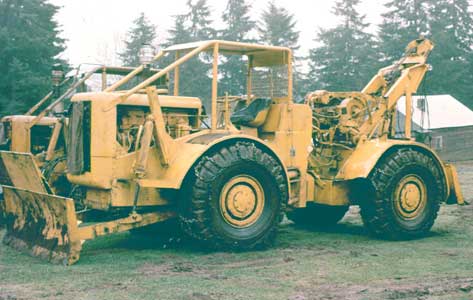
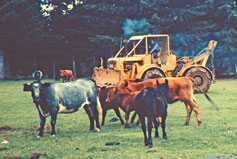


|
| WG14 Side view |

|
| Smaller Wagner features a supercharged Cummins JS-6 with 160 hp. on 14x24 rock service truck tires. Allison Powershift. |

|
While massive yarders and railroads addressed the logistics of massive logging operations in large timber stands, the open grounds left behind these large log operations did not go fallow. As might be expected they grew back to their native species which was of course more timber. This vibrant and wildly productive regrowth was different from the trees that they replaced only in that they were smaller, faster growing, and healthier. By the 1950's the Pacific Northwest Forests were ready for harvesting of regrowth timber, but alas, the equipment of a previous generation designed for much larger timber was inherently unsuitable.
Gone for good were the days when a railroad could be punched into an area and the timber hauled out a township at a time. Rather, the shifting paradigm of forest practices, and available timber called for logging smaller tracts, and often just thinning. Railroad logging faded quickly after World War II. Smaller more flexible methods of getting the wood out were needed.
Although cable logging is still used today where rough terrain dictates it, the evolution of heavy equipment during the last 50 years has made ground logging once again feasible. Caterpillar perfected the development of the bulldozer in the 1930's and it became widely available after World War II. Trucks replaced rail as the preferred method of hauling the logs and accordingly in favorable terrain, the bulldozercould build a truck road right into the woods and could also with a winch on the back, yard the logs a short distance for loading on the truck. Steel tracks are expensive and innovators were looking for ways to log with rubber tired equipment as early as the mid 1950's.
The generic bulldozer, has always been used some for logging, sometimes just with a towing winch, sometimes with a trailer type Arch, sometimes with an integral arch and in recent years even with grapples. Indeed Caterpillar now makes specially balanced versions of its D4H and D5H tractor dozers for skidding. The track frames are moved to the rear so the machines will balance better with a skidding load. However nifty dozers are, there is a general consensus that except in extreme (as in bad) conditions the rubber tire does a better job of moving logs further, cheaper and faster, than the steel track.
The Wagner Brothers of Portland Oregon (later to be split into FWD Wagner, Scoopmobile, and Wagner Mining Scoop) made several early prototypes of rubber tired log skidders in the mid 1950's. VanNatta Bros. ultimately acquired and used for years 2 of these machines, though there were quite different. Wagner is generally credited with perfecting the 'articulated design' for heavy equipment . An Articulated machine 'bends in the middle' to steer instead of having steering wheels such as are found on a car or jeep. The principal business of Wagner was building rubber tired front end loaders.

|
| Double winches on Wagner LG-14 -- upper winch is Carco E22 hydraulic and lower winch is PTO Gearmatic 19 |

|
These scoops on rubber tires ultimately displaced the classic 'steam shovel' on most aggregate loading jobs. With teeth (forks) instead of a bucket they became log loaders of choice where space was available. Caterpillar, Michigan, Allis-Chalmers, and Hough all entered the rubber tired loader marked with steered machines before yielding the superior design of the articulated model (steerable driving axles are expensive, and vulnerable to breakage--also the articulated machine will turn in a much tighter radius). Anyhow, back to the point.
Wagner made some early log skidders (the ones owned by VanNatta Brothers were build in 1955 and 1956). They were essentially modified front end loaders. They weighed in at between 30,000 and 40,000 lbs. and were equipped with 160 hp Cummins engines. The drivers compartment was turned to face over the engine and an arch and winch were installed in lieu of the loader buck and arms. The machines were of limited success and did not catch on because of the tire problem. Large low pressure tires had not been invented yet. The only big tires available at the time were the high pressure tires used by large mining trucks (which were also suitable for front end loaders which usually work on hard ground). Of the two skidders one was equipped with 14X24 - 20 ply Rock service tires and the other had 18 X 25 20 ply Rock service tires. They were tough tires and the original ones were still on the machines when they were retired nearly 30 years later, but they were intended for hard surface roads,and failed to provide the flotation necessary for working in the soft forest ground.
In the Pacific Northwest, at least, Garrett first popularized the log skidder by first producing a much smaller machine which was small enough and light enough to work with farm tractor tires of the day. As the market caught on in the later 1960's rubber tired skidders appeared from a number of companies including a lot of start ups as well as old line companies. Among those that come to mind are Athey, Pettibone, Franklin, Can-Car, International, Cat, Clark, Timberjack, John Deere. (all of these names are somebodies trademark). The first Garret's that I saw were powered by small Ford gas engines. The small gas powered skidders quickly gave way to a larger model. In the early 1970's the 'standard' rubber tired log skidder typically was around 20,000 lbs in weight and sported approximately a 100 hp. engine. The Detroit 3-53 engine was very common, though John Deere and Cat have always used engines of their own manufacture. As the '70's wore on the Detroit 3-53 engine gave way to a Detroit 4-53 engine (These engines were a 2-stroke diesel with the first number denoting the number cylinders and the last sequence denoting the displacement in Cubic inches per cylinder.) These engines are legendary for their light weight, durability, noise and smoke. A typical tire for this class of machine was a 23.1 X 26 logger service tire. From a distance they looked much like a farm tractor tire, but had wire belts in them and re-enforced beads to resist punctures from sticks and to withstand the 'curb scrubbing' inherent in hitting ends of logs with the side of the tire.

|
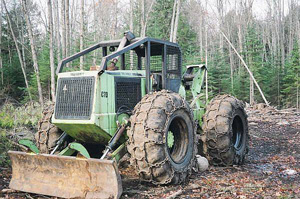
|
| Can-Car C7D line machine |
To the left here is a Can-Car C7D with a fixed grapple. With a Detroit Diesel 4-53 engine and a hinge grapple, it was archetypical upper end of the market in the mid 1970's skidders. A tremendous recession hid the timber industry in the early 1980's and there was a major shakeout in the logging machinery market.. When the market righted itself in the later 1980's, Cat and John Deere appeared to dominate the market. with Clark and Timberjack still to be found. Each had their niche. Cat is legendary in the Pacific Northwest for its quality and durability. John Deere is famous for having a credit plan that will meet ones needs (It doesn't matter how good it is if you can't buy it), and Clark and Timberjack held a spot because they were made largely of generic parts which makes them cheaper to fix, the vertically integrated manufactured Cats and John Deeres. The main change in these machines over the last 20 years is that they continue to get modestly larger heavier and more powerful. The design is similar. Engine, converter, powershift transmission, articulation, mechanical drives to outboard plantaries. John Deere has varied the formula by using a powershift transmission without a converter and closed center hydraulics (both adapted from their farm equipment) while the others have used a slush pump and open center hydraulics. A few readers have read these remarks as a slam of John Deere. That isn't intended. Their powershift with a hard drive is just different, and perhaps more efficient than the slush pump drives. This makes them a bit of a maverick in the business and results in a product that is genuinely different.
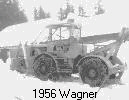
|
One of the most interesting observations, to this writer, is the fact that the prototype Wagner machines, though made in the 1950's on special order, contained many features that the production model skidders of the 1960's lacked. To be sure, the Wagners had a problem in that large, low pressure farm tractor type tire hadn't be built yet in a size big enough for their weight, but the did have such forward looking features as air brakes, automatic transmissions, and differential locks.
Indeed the first skidder that this writer ever saw was a Timberjack which a neighbor bought new in about 1963. It ran on 4 large farm tractor tires and was powered by a "I can hear it coming" 3-53 Detroit Diesel. It was a mean machine with a lot of ground clearance and plenty of floatation and traction, but alas, the designer had never been to Oregon. This machine had a manual transmission which looked like something that had been found in a spare parts bin for a Dodge Power Wagon and the only brakes on the machine was a band brake on the back of the transfer case which looked like a parking brake retrieved from the same Power Wagon. The second skidder that this writer ever layed eyes on was a Garett 15. This was a much smaller machine and one has to give Garrett credit for firs popularizing the rubber tired skidder. They were called "Tree Farmers". This model had a small Ford Gas engine, a manual transmission and the familiar driveshaft brake.

|
| Two Wagners -- Rear View |
There is a place, you see, in the world for a driveshaft brake, but stopping a log skidder on a mountain is not one of them. We all should understand that brakes quickly loose their effectiveness when they overheat. We call it brake fade. Due to the gear reductions in the differential and planetary drives a drive shaft rotates much more rapidly than the wheels do. This means that a driveshaft brake effectively has a lot more leverage for the purpose of holding a vehicle, and a very small brake band will hold a very heavy load. Notice, I said 'hold' not 'stop'. If you try to use such a brake to slow a heavy vehicle, it overheats and fails very quickly. This is why a driveshaft brake is suitable for parking, but not as a service brake. Apparently, all the design engineers of these machines had never been out of Florida, where heavy machinery always stops moving in every direction except down, if you stop the engine. You have no idea how thrilled we where to find massive drum brakes in the wheels of the Wagners. The first and smaller of the 2 Wagners had air over hydraulic drum brakes in all for wheels, and the machine pictured here had full air brakes utilizing parts compatible with those used in highway trucks today. In case you are wondering, an 'air over hydraulic' brake is a hybrid braking system which has features of both air brakes and hydraulic brakes. teh operator applies the brakes via a classic air treadle valve but instead of this activating air cans which mechanically set the brakes, there is but an air can connected to a hydraulic master cylinder which in turn controls the braking. This is a design alternative to the 'power brakes' found in most cars today. The power brake on a car as typically appears today is actually a "vacuum assisted' brake control in that the brakes are activated by a mechanical linkage from the 'brake pedal' to the hydraulic master cylinder but in addition there is a vacuum can on the linkage which provides a vacuum assist to increase the pressure. An air over hydraulic brake will have no mechanical connection between the operator and the master cylinder, and the brake pedal on the floor board simply opens an air valve to feed air into the system.
The downside of these hybrid brakes is reliability. Their successful function depends on both the hydraulic brake subsystem and the airbrake subsystem to work, and if either fails there are no brakes. Although the technology of both hydraulic brakes and air brakes is well understood and very reliable, the combination seemingly provides 2 opportunities for failure. Today we rarely see air over hydraulic technology applied to the activation of drum brakes. Of course, we rarely see drum brakes in heavy machinery any more. The trend over the last 20 years has been toward disc brakes. That is what the Cat 528 has, and a discussion of them will be provided there.

|
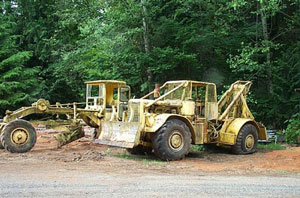
|
I have no particular clue how many of the Wagner skidders were made, as we bought the only two that I had ever heard of or seen acquiring our first one in 1967 (obviously used) and a the large one at an auction in 1973 or so. While I'm pretty certain that there weren't many of them, the photo on the left came to me in 2007, suggesting that at least one lived on in Washington state until this time. It is similar to our large one but not quite the same suggesting some evolution in design. If I had to venture a guess I would say that this one is a later one, but who knows.
The heavier canopy makes me think newer, and the tires are different. Ours was fitted out with recapped 18x25 truck tires, and this one looks like it had some sort of a tractor tread. The tires on ours wore out the machine, but these look like the tread is worn off.
This one shows the original blade configuration. We modified our blade in 2 respects. We converted it to a tilting blade, and further modified the lift cylinder placement. As Wagner designed it the blade came up in the air 2 feet and went below grade 2 feet. This wasn't high enough to keep from getting hung up and there was no reason for it to dig that deeply so we rearranged the blade so it came up 3 feet and went down 1 foot.

|
Automation has been a part of the industrial revolution. Until the advent of the chainsaw after World War II all felling and bucking was done with hand saws. A cable was then placed around the log and some machine was used to drag the log off to where it could be hauled to market. This required tremendous amounts of manpower. With a cable skidder a single operator can drive the skidder out to a place near the fallen tree, hook on to it and drag it away., but alas, the unpleasant and tedious job of hooking and unhooking remains. In logger speak, hooking up logs in the woods is called 'choker setting' and releasing them in the landing is called 'chasing'. The opportunity for the next level of automation is to get rid of the cables and the chokers. What you see here is an ESCO swinging Grapple. This device was designed and manufactured by a Portland Oregon company (called ESCO) who has historic expertise in steel castings particularly for the logging industry. the idea is that the operator can drive out near the log, and then swing and extend the boom over and grab the log and proceed to the landing without further ado. This is a great idea, and where it works a wonderful time saver. The swinging Grapple is particularly wonderful in a thinning operation because it helps you wiggle the log out of the standing timber without damaging it. It is also not without its limitations, however. It is not particularly conducive to handling more than one log at a time, and swinging out to the side can destabilize the skidder, overturning the machine. These swingers have a lot of moving parts including a fairly expensive to repair rack and pinion swing mechanism which make them fairly expensive. Stated bluntly, the swingers have seen limited acceptance in the timber industry. Interestingly, a fixed boom grapple configuration has seen much greater acceptance. The Fixed boom grapple uses the same sort of a grapple unit, but it is mounted on a short boom which only extends to the rear and goes up and down. Such a machine is not as versatile at reaching logs, but has fewer moving parts, and does not compromise the stability of the machine. It is particularly suitable for working behind a mechanical harvester which will snip off several trees and drop them along a trail in a bunch.
Back when ESCO made 2 sizes of the swinging grapples. The smaller model was a bit small and was clearly only suitable for fairly light work. The larger model shown here was big enough. It is identifiable by 8 inch bore hydraulic cylinders on the boom and dipper. It is no longer made, and in lieu thereof ESCO makes a smaller model which is beefed up structurally so it won't come apart. Naturally these larger old swingers are much coveted and loggers tend to cut them off of old skidders, rebuild them and move them on. Treetow of Canada has moved into the large swinger market abdicated by Esco. For a rundown on their product see our 1997 Morganpage. The problem with the big model is that it was often installed on a less worthy skidder than this CAT 528, which made the over all skidder a bit unstable and unbalanced, because the unit was a bit too large. Garrett was famous for making a 50 lb skidder and packaging it in a 40 lb box, and we have one of those called a Garret 30A. It has just as much power as the 528 and has the same grapple, but weighs 5-10,000 lbs less. It does a tremendous job of pawing the ground and making noise, but you also learn to carry a spare drive line in the crummy, because if it ever does get traction, it would just as leave crack a drive line as the governor.

|

|
An alternative to a swinging boom grapple is a fixed boom. Seen here is a Can-Car C7d with a Simple Hinge fixed boom grapple. The support piece is hinged and moved by hydraulic cylinders. To operate you back up to a log, lower the grapple over it, pinch up the log (or logs) by closing the grapple and then lift it by folding the whole assembly forward. Then it is off to the landing. This machine is of a mid-1970's design with a Detroit 4-53 engine. This is an older style hinge grapple. Most newer fixed boom grapples have a compound linkage which allows them to extend to the rear as well as drop down. This provides them with more reach behind the machine than is possible with a simply hinge grapple. TheMorgan SilvaCom provides a modern example of the compound fixed grapple. Unlike the swinging grapple which is almost and ESCO exclusive, a number people make the fixed boom grapple, and they come close to being standard for rubber tired skidders these days, mostly in the compound configuration. They work well for forwarding bunches of logs as left behind by a mechanical harvester or feller buncher. the dual function compound grapple had the advantage of a bit more reach which is very helpful if there is a stump between you and the bunch or the ends of the bunch are not even.
To the left here we see a very contemporary John Deere 748E with a dual function grapple. Notice the 2 sets of hydraulic cylinders on this 165 HP machine. The compound functions provide more reach to the rear than the simple hinge grapple. Reach is everything with a grapple. Just out of reach. there is always a stump between you and the log. Where do you suppose the tree came from??? The extra reach helps reach over the stump (or what ever) to get the log.